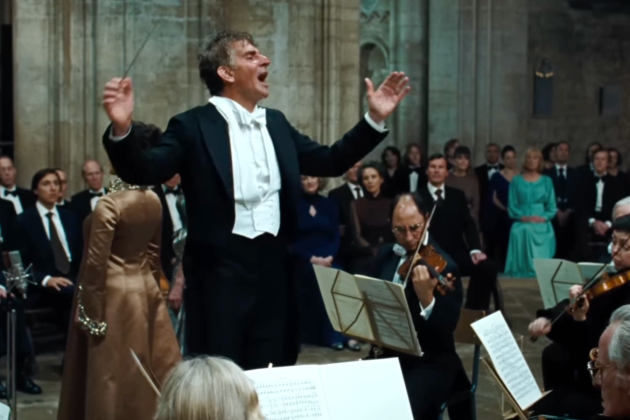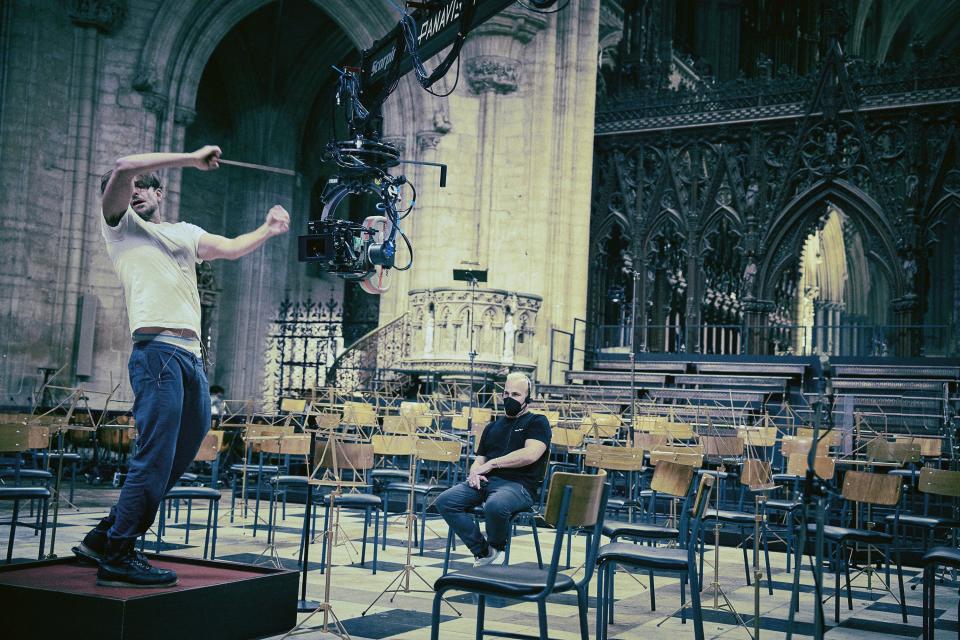How Bradley Cooper Nailed His Six-Minute ‘Maestro’ Conducting Scene in One Take: ‘Singing at the Oscars’ Doesn’t Even Compare
- Oops!Something went wrong.Please try again later.
- Oops!Something went wrong.Please try again later.
- Oops!Something went wrong.Please try again later.
- Oops!Something went wrong.Please try again later.
- Oops!Something went wrong.Please try again later.

In “Maestro,” Bradley Cooper disappears into the role of legendary composer and conductor Leonard Bernstein, one of the most consequential American figures in classical music. Like his 2018 directorial debut, “A Star Is Born,” Cooper also co-wrote, produced and directed the film. In his conversation with Emma Stone for Variety’s Actors on Actors series, he spoke at length about the six years he spent devoting himself to bringing Bernstein’s singular life to the screen.
At one point Stone (there to discuss her own performance in “Poor Things”) talked about going to Cooper’s house with her mother to watch a cut of “Maestro,” which reduced them both to tears. Stone was especially stunned by a scene, roughly two thirds into the film, in which Cooper as Bernstein conducts Gustav Mahler’s Resurrection Symphony at Ely Cathedral in England in 1973.
More from Variety
How Chanel Helped 'Maestro' Costume Designer Mark Bridges Recreate Iconic Tweed Suit
Variety's 'Actors on Actors' Racks Up Record-Smashing 145 Million Social Media Views
“Full body chills,” Stone said. “It felt like I was watching a true conductor, a master at work.”
Unfolding largely in a single, six-minute take — and shot in the actual cathedral, with a live orchestra and choir, and an audience of extras — the scene serves as a critical turning point in Bernstein’s relationship with his wife, Felicia (Carey Mulligan), as well as the emotional climax of the movie. But it might have looked very different. In a riveting monologue, Cooper explained how he worked for years with two leading conductors — Gustavo Dudamel, music director of the Los Angeles Philharmonic, and Yannick Séguin, music director of the Metropolitan Opera — to prepare to conduct the piece live on camera, only to end the day of shooting feeling like it was, instead, a “nightmare.”
Here, in Cooper’s own lightly edited words, is the full story of how the filmmaker saved the scene.
“This was such a tricky movie to structure and figure out what I was even going to do. I knew that I didn’t want to make a biopic, but I also knew that if I put his music in the movie, then that would do everything that a biopic would ever do anyway. If you want to learn about Martin Scorsese, just watch all of his films rather than watch his interviews. So early on, I wanted a classical pillar for his classical music. He loved Gustav Mahler, and when I was researching it, for some reason I had never heard Mahler’s music. I don’t know how I missed that, but I missed it.
“That to me is the most powerful piece of music I’ve ever heard in my life, and he conducted it. It was one of the first things I had researched six years ago. There’s a YouTube video of him conducting in Ely Cathedral, this huge gothic cathedral, which at one point was the biggest gothic cathedral in the world, in the ’70s with the London Symphony Orchestra. It just encapsulates everything you ever want to know about him as a conductor. His ability to harness that music, to be in the center of the sun and not burn, but instead just shine the light back onto us.
“I thought, ‘Well, if I could figure out how to conduct just those six minutes at the end, that could be that piece of that pillar for the movie.’ The benefit was that I knew six years ago. Then I just started researching, and I was able to get the footage of him literally conducting that piece.
“Then Gustavo Dudamel was kind enough to work with me for the last six years. He conducted that piece with the LA Phil at the Hollywood Bowl, and I was with him from the first rehearsal all the way to the last rehearsal. Then three and a half years later, I traveled with him to Berlin and spent two weeks with him with the Berlin Philharmonic, which is arguably the best orchestra in the world in one of the best halls in the world. He did that same piece with them. Then Yannick Séguin was there with me through all of the shooting. I had an earpiece [and] he was in another room just making sure that I knew the tempo for the time changes, even though I couldn’t hear it because it was so loud.

“I made this movie fearlessly; there’s really nothing in the cutting room floor within the scenes. They are just what they are, which was wonderful for the actors and also challenging. But that scene, I had five different [camera] setups, and I realized it was all out of fear that I wasn’t going to be able to pull it off. We were doing it live with 130 orchestra members. These are all unicorns. They’re the best at what they do. Luckily, they’re the greatest orchestra in the world, but still, I had to conduct them because the shot is seeing everybody. You just would know it if it wasn’t happening.
“Conducting is the hardest thing. People are always like, ‘What’s conducting?’ You’re keeping tempo a little bit ahead, and you’re also reminding everybody these things that you’d worked on in rehearsal. I just kept messing it up. The minute I was behind tempo, it’s over. I’m lost. Imagine that. First of all, I’m Lenny. I’m directing it. And they don’t really give you anything, these musicians. It was a nightmare.
“I went to bed and I texted the sound mixer, at, like, 2 a.m., saying, ‘Do we have it?’ That’s how vulnerable I was. I’m texting the sound mixer. Then he wrote me back. He’s like, ‘I think so?’
“We didn’t have it though. The next morning, we were supposed to shoot that outdoor scene with the cathedral. There was a scene of [Felicia] driving up that I didn’t keep in the movie. So we had a Technocrane for that.
“I was at work six hours or five hours before crew call [to] become Lenny. Then I’d be able to walk in the set a little bit maybe before even anybody came, the crew. I walked into that church, and it was empty. We’re not supposed to shoot there that day. I looked up, and I have a conversation with him and I was like, I got to give it one more shot. They all came in, the crew. I said, ‘Guys, before we go outside, I know we have time. Let’s bring the Technocrane in.’
“It was so crazy, this huge. 40-foot techno crane we’re bringing in the bowels of the cathedral. I asked everybody to wait. I set up the shot of one take. It took an hour and a half to set up. Then I brought everybody back in, and I actually said a prayer to Lenny in front of everybody, like, ‘Thank you for this opportunity. We’re going to do it again.’ That’s what’s in the movie. It was one take.
“When it ended, the timpanist came running up and he was like, ‘You know what you did yesterday? It was total shit. Today, you conducted us.’ I was like, ‘No, no, I know. I know.’ ‘No, no, you don’t understand. You can’t use yesterday at all.’ I was like, ‘No, no, no, we’re not. We got it. We got it. We got it.’
“My memory of that take was that I was actually floating above the orchestra, and that I was able to point to each musician. Singing at the Oscars, playing at Glastonbury, didn’t even compare to what that experience was.”
Best of Variety
Sign up for Variety’s Newsletter. For the latest news, follow us on Facebook, Twitter, and Instagram.

